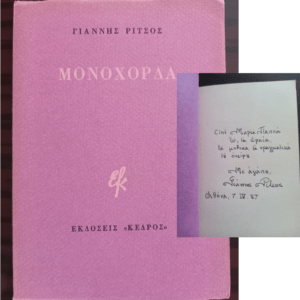ANGELOS SIKELIANOS, DEATH OF DIGENIS, 1947, First Edition, 1/1000 Copies, Spyros Vassiliou
95.00€
Spyros Vassiliou (1903 – 1985) was a Greek painter, printmaker, illustrator, and stage designer. He became widely recognized for his work starting in the 1930s, when he received the Benaki Prize from the Athens Academy. The recipient of a Guggenheim Prize for Greece (in 1960), Spyros Vassiliou’s works have been exhibited in galleries throughout Europe, in the United States, and Canada.
Out of stock
Description
Άγγελος Σικελιανός
Ο Θάνατος του Διγενή
Angelos Sikelianos
The Death of Digenis
First Edition
Published by Ikaros in Athens in 1947
in 1000 Numbered Copies (Here: No 820)
Woodcuts by Spyros Vassiliou
108 Pages
26,5cm x 17cm
Original Paper Binding with protection folio
In very good + condition
Angelos Sikelianos (1884 – 1951) was a Greek lyric poet and playwright. His themes include Greek history, religious symbolism as well as universal harmony in poems such as The Moonstruck, Prologue to Life, Mother of God, and Delphic Utterance. His plays include Sibylla, Daedalus in Crete, Christ in Rome, The Death of Digenis, The Dithyramb of the Rose and Asklepius. Although occasionally his grandiloquence blunts the poetic effect of his work, some of Sikelianos finer lyrics are among the best in Western literature. Every year from 1946 to 1951, he was nominated for the Nobel Prize for Literature. (Wikipedia)
The Death of Digenis or Christ Unbound, is a tragedy by Angelos Sikelianos written and published in 1947. Three years later, in 1950, the music of the play was written following a cooperation between Manos Hadjidakis and Sikelianos.
The work focuses on the last moments of Digenis Akritas. Sikelianos uses the acritical cycle (frontiersmen tales) for the historical material (i.e. the conditions and some historical figures of the time, such as the Byzantine Emperors Michael III and Basil I) and the image of Digenis, whom he places as leader of a heretic group of Paulician warriors, adjusting and transforming the historical material according to his own dramaturgical and ideological objectives (particularly the importance of the hero’s tomb and other relevant issues).
The work focuses on the last moments of Digenis Akritas. Sikelianos uses the acritical cycle (frontiersmen tales) for the historical material (i.e. the conditions and some historical figures of the time, such as the Byzantine Emperors Michael III and Basil I) and the image of Digenis, whom he places as leader of a heretic group of Paulician warriors, adjusting and transforming the historical material according to his own dramaturgical and ideological objectives (particularly the importance of the hero’s tomb and other relevant issues).
Mainly due to its second name, this tragedy has been associated with the third part of the lost Promethean trilogy by Aeschylus, Prometheus Unbound, with Digenis being presented by Sikelianos with the same characteristics: a social and cultural fighter – revolutionary for the good of the people – Prometheus, more or less, offers culture to mankind – a hero that links Christ and Prometheus, while there are other scholars’ opinions that consider Hercules top have served as a model, as well as Oedipus (mainly in relation to the issue of the initiation of the hero and his death – as the return to Mother Earth). In general, ancient Greek tragedy – not only the lost Promethean trilogy – has been used by Sikelianos for the rendering of other persons through an implicit link with characters of ancient drama (Emperor Michael III, Monk Hilarion).
Additional information
| Languages | Greek |
|---|
You may also like…
-

Angelos Sikelianos, Mater Dei, Mitir Theou, Robert Levesque, 1944, Mater Dei, Signed, 1/500 Copies, Albert Bequin
385.00€ Add to cart -

Signed, 1966, JAMES MERRILL, VASSILIS VASSILIKOS, STRATIS TSIRKAS, POEMS, GREECE
175.00€ Add to cart -

SIGNED and INSCRIBED by Angelos Sikelianos and Publisher Skazikis, Kostis Palamas, 1943, First Edition
80.00€ Add to cart















